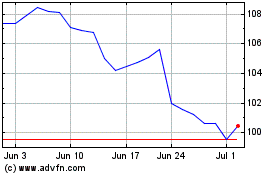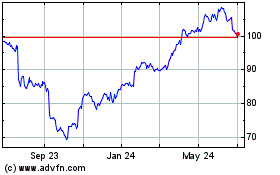By Paul Vigna and Alexander Osipovich
Stocks surged Tuesday on optimism about economies reopening and
the potential development of a coronavirus vaccine, extending a
rally that has pushed major U.S. indexes up more than 30% since
late March.
The Dow Jones Industrial Average climbed more than 500 points
after the three-day holiday weekend and flirted with the 25000 mark
for the first time since early March. The rally was driven by
economically sensitive shares in the financials and industrials
sectors. Goldman Sachs rose 9%, Raytheon Technologies gained 7.5%
and Dow rose 7.4%.
Investors cheered signs of economic activity resuming faster
than expected across parts of the U.S. and elsewhere in the world.
Restaurant bookings and spending on hotels and airlines appears to
be picking up in the U.S., coinciding with a decline in the daily
number of new infections.
The U.K. has laid out plans to reopen retail stores next month,
while Italy, one of the hardest-hit countries, saw people return to
bars and restaurants over the weekend.
Stocks have quickly recaptured a level of euphoria usually seen
at market tops, said Peter Boockvar, chief investment officer at
Bleakley Advisory Group. That's because stock traders are looking
only at the direction of the recovery, while bond markets are more
concerned with the degree of the recovery, he said.
"As long as things are reopening, the economic data don't
matter," Mr. Boockvar added.
The New York Stock Exchange's famed trading floor also reopened
Tuesday -- incidentally, the 124th anniversary of the start of the
Dow Jones Industrial Average. The floor had only around one-quarter
of its usual number of traders and new social-distancing rules to
limit the spread of Covid-19.
Ahead of the open, floor traders queued up outside the NYSE's
historic building in lower Manhattan, standing on blue markers on
the sidewalk to ensure they maintained a six-foot distance from one
another, before submitting to a temperature check. A mask-wearing
New York Gov. Andrew Cuomo rang the opening bell, facing a largely
vacant trading floor.
The governor flubbed a NYSE tradition under which visitors are
expected to ring the opening bell for 10 seconds, letting the bell
go quiet after just a few seconds. That prompted NYSE President
Stacey Cunningham, standing at his side in her own mask, to urge
him to ring it again. He did so.
Several banks including Bank of America Merrill Lynch, JPMorgan
Chase and Morgan Stanley declined to send their representatives
back to the NYSE floor Tuesday as they were still hashing out a
dispute over the exchange's efforts to shield itself from liability
for coronavirus-related lawsuits, people familiar with the matter
said.
The NYSE is seeking to make the banks and other firms that
employ floor brokers agree to compensate the exchange for certain
lawsuits arising from a Covid-19 outbreak, The Wall Street Journal
reported Monday. Although most floor brokerages have signed the
NYSE's agreement, some banks have balked at it, the people
said.
Another exchange operator, Cboe Global Markets, said Tuesday it
would reopen its options-trading floor in Chicago on June 8. Cboe,
whose floor has been closed since March, said it expected around
50% of its traders to return to the facility, which is being
reconfigured to help them abide by new social-distancing rules.
Tuesday's rally sent the blue-chip index up 529.95 points, or
2.2%, to 24995.11. The S&P 500 rose 36.32 points, or 1.2%, to
2991.77. The technology-heavy Nasdaq Composite rose 15.63 points,
or 0.2%, to 9340.22.
Investors are betting that one of at least 10 coronavirus
vaccines under development will eventually come to market, halting
the spread of the coronavirus and allowing normal business and
social activity to resume.
Novavax said Monday that it started the first human study of its
experimental vaccine. Drugmakers including Pfizer and Moderna are
also racing to develop a vaccine. Novavax shares rose 4.5% to
$48.17, after rising as high as $54.50 earlier in the session.
Moderna fell 16% to $57.71. Pfizer slipped a penny to
$37.49.
"It looks like we have several shots on goal," said Hani Redha,
a multiasset portfolio manager at PineBridge Investments. Although
manufacturing a vaccine and disseminating it to the wider
population will take time, the number of potential candidates has
buoyed markets.
"Any kind of glimmer of hope about any trial going well or any
trial starting is going to be good," he said.
In another sign investors are embracing risk, a range of assets
typically considered safe declined. Gold futures dropped 1.7% to
$1,704.80 a troy ounce, while the WSJ Dollar Index declined 0.9% as
investors favored riskier areas of the market like commodities and
emerging markets.
It's unusual for gold and the dollar to be down at the same time
because a weaker dollar makes gold and other dollar-denominated
assets cheaper for overseas buyers. The synchronous drop
underscored the strength of Tuesday's "risk-on" move.
Treasury yields also ticked higher as investors retreated from
safe assets. The yield on 10-year Treasurys rose to 0.697% from
0.659% Friday as bond prices fell.
In oil markets, the main U.S. crude gauge advanced 3.3% to
$34.35 a barrel, rising for seven of the past eight sessions.
Despite the recent stock rally, many investors remain concerned
about how to value shares when earnings have fallen so sharply and
many companies have withdrawn their future forecasts.
The market rebound has pushed the S&P 500's forward-looking
price-to-earnings ratio to 23.36, its highest level since 2002. But
corporate profits are expected to remain under pressure until next
year as sales tumble and expenses rise.
"It's safe to say it's going to be a couple of years," before
earnings recover, said Mr. Boockvar of Bleakley Advisory.
After S&P 500 operating earnings hit $157 a share in 2019,
they are projected to fall to $111 this year and rise to $162 in
2021, according to estimates from Howard Silverblatt, the senior
index analyst at S&P Dow Jones Indices.
"If we see the upward turn in earnings, then the current levels
may be justified," Mr. Silverblatt said. "If not, the Street will
need to reprice."
Caitlin Ostroff and Joanne Chiu contributed to this article.
Write to Paul Vigna at paul.vigna@wsj.com and Alexander
Osipovich at alexander.osipovich@dowjones.com
(END) Dow Jones Newswires
May 26, 2020 17:30 ET (21:30 GMT)
Copyright (c) 2020 Dow Jones & Company, Inc.
RTX (NYSE:RTX)
Historical Stock Chart
From Mar 2024 to Apr 2024

RTX (NYSE:RTX)
Historical Stock Chart
From Apr 2023 to Apr 2024
